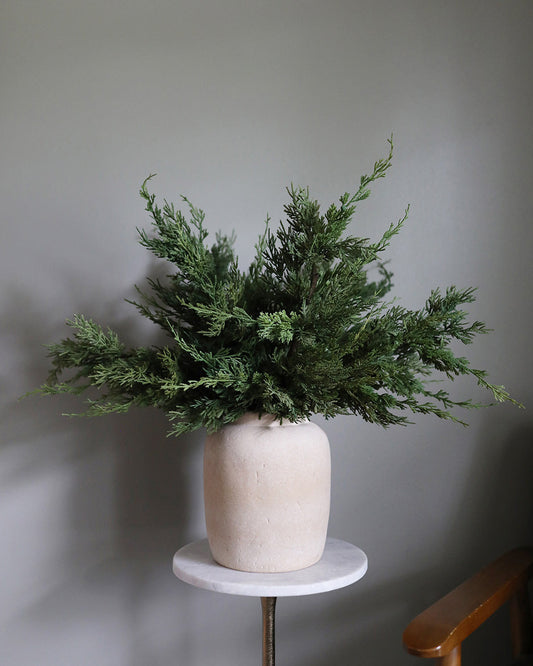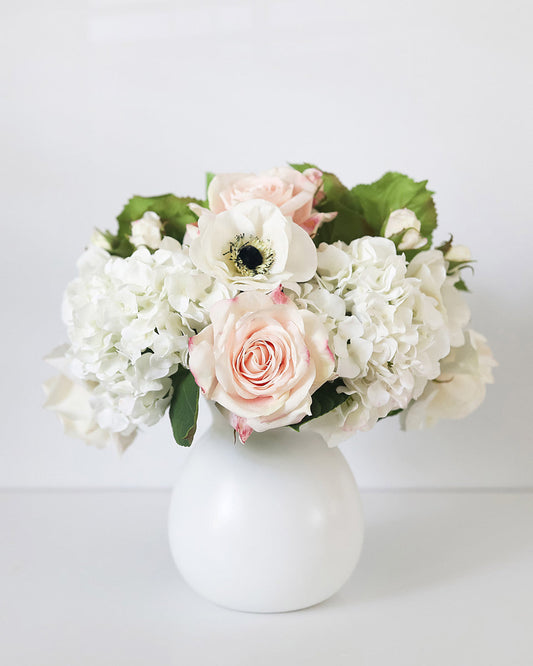Creating Stunning Floral Displays: The Art of Color Harmony with Artificial Blooms

Flower arranging is an art form that transcends seasons and spaces, offering endless opportunities for creativity and expression. Whether you're a seasoned florist or an amateur enthusiast, understanding the principles of color theory can bring your floral arrangements to new heights. In the realm of artificial flowers, where an extensive palette of hues is readily available, mastering color theory becomes even more crucial. In this article, we delve into the world of color theory in flower design as well as explore the understated beauty of monotone arrangements and why they deserve a place in your floral repertoire
UNDERSTANDING COLOR THEORY
Color theory forms the foundation of flower arranging, influencing everything from mood to visual appeal. Warm tones like reds, oranges, and yellows exude energy and passion, while cool tones such as blues, greens, and purples evoke calmness and tranquility. One of the fundamental principles of color theory is the concept of opposing or complementary colors, which are located directly opposite each other on the color wheel. Understanding how to effectively use opposing colors can enhance the visual appeal and balance of floral arrangements.
Opposing colors create dynamic contrast and visual interest when paired together in a floral design. They intensify each other, making the colors appear more vibrant and vivid. For example, red and green are opposing colors, as are purple and yellow, and blue and orange (and variations of all those mentioned). When these complementary hues are strategically combined in a floral design, they create a beautiful balance that captures the viewer's attention.

Incorpotating opposing colors in floral design can be achieved in various ways. One approach is to use flowers that naturally exhibit opposing colors. For instance, pairing red roses with lush green foliage or incorporating purple hyacinth with bright yellow ranunculus creates a striking contrast that draws the eye.
By harnessing the power of complementary hues, floral designers can elevate their arrangements to new heights, captivating viewers with dazzling displays that celebrate the vibrant spectrum of colors found in nature. Whether it's a bouquet bursting with contrasting blooms or a subtle arrangement that plays with complementary accents, incorporating opposing colors adds an extra layer of visual intrigue to any floral design.
ANALOGOUS FLOWER ARRANGEMENTS
Analogous flower arrangements artfully blend together colors that sit adjacent to each other on the color wheel, creating a seamless transition. By selecting flowers within the same color family or those with similar undertones, analogous arrangements evoke a tranquil and cohesive aesthetic. For example, a flower arrangement featuring varying shades of pink, coral, and orange blooms exudes warmth and vitality, while a composition of cool blues, greens, and purples evokes a serene and soothing atmosphere. Analogous arrangements offer versatility and flexibility, allowing arrangers to play with subtle variations in hue, saturation, and intensity to achieve their desired aesthetic.
THE ARTISTRY OF MONOTONE ARRANGEMENTS
Contrary to the vibrancy of multicolored displays, monotone arrangements portray a refined sophistication that captivates with its simplicity. By focusing on a single color or varying soft shades of a particular hue (pale blush or creamy yellow), these arrangements highlight the intrinsic beauty of each bloom. Monotone compositions have the power to inspire serenity and elegance, rendering them perfect for establishing a unified ambiance in minimalist interiors or upscale events.

Monotone arrangements showcase the subtle nuances and textures of artificial flowers, allowing each bloom to shine individually while contributing to a harmonious whole. Whether it's a monochromatic bouquet of cream real touch roses or a lush arrangement of pale pink peonies, monotone compositions offer endless possibilities for creativity and expression.
_______________________
In the realm of flower arranging with artificial blooms, color theory serves as a guiding principle for creating floral compositions that delight the senses. While multicolored displays dazzle with their vibrancy, monotone arrangements offer a timeless elegance that celebrates the beauty of simplicity. Whether you prefer the dynamic energy of a kaleidoscope of hues or the understated sophistication of a single color palette, there's no denying the transformative power of color in floral design.










